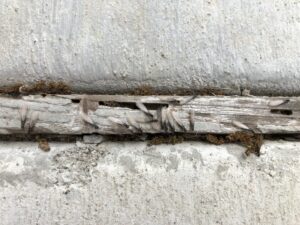Top 5 Signs of Termites
Found in all U.S states except for Alaska, termites are considered a national pest problem. Estimated to cause $5 billion in property damage each year, termites can be nesting in properties for years before being found. Small and soft-bodied, these insects live in large colonies and destructively feed on various types of wood and cellulose-based plant material. From skirting boards to furniture, the destruction to a property caused by termites is immense.
Whether you have subterranean termites building mud tubes to food sources, or dampwood termites swarming to form a new colony, being proactive and learning about the early signs of termites is key. It may not be too late to save your home or business from thousands of dollars of destruction.
Take a look at the top 5 signs of termites below for tips to spot signs you have termites and help prevent future property damage:
Termite Swarmers
Termite swarmers, fertile female and males looking to mate and create new colonies, are one of the first signs of termite infestation you will see. The best time to check for swarmers is during swarm season, generally after a rainy day that follows a dry spell. Once spotted in the vicinity, there is a high chance your property could be infested or at risk of being infested, so make sure to get inspected.
Although this is one of the signs of termites in the house, this does not necessarily mean these insects are within your property. Dependent on swarm size and its location, this could just mean that there is a nest or nests within proximity of your area. As termites are poor fliers, they do not fly beyond 328 feet from their nest.
Discarded Wings
Discarded termite wings range from ¼ to ½ an inch, with queens and kings capable of growing wings up to an inch long. Found near closed doors, windows, and home-access points, discarded termite wings are found as a result of the formation of a new nest. When termites are in search of a new nest site, they will sprout wings and swarm. Once a new nest is established, the termites will twist their wings off and dump them in giant piles, as they will not need to use them again. The discovery of a pile of discarded wings indicates that there is, or recently has been, a termite nest nearby.
Mud Tubes
An interesting, and often easy to spot, sign of termites in a home are mud tubes. They are found wherever the ground comes into contact with a food source, mud tubes are pencil-sized tubes created by subterranean termites. Constructed from saliva, dirt, and feces, mud tubes can extend up to 15 feet above the ground when built on walls. As this particular type of termite requires certain humidity levels and temperatures to survive, nests are built underground with mud tubes created to block out dry and cool air as they travel for food. These tubes give termites a way to forage and work while still giving their home an environment they can thrive in.”
Termite Droppings
Often referred to as frass, termite droppings are tiny pellets found mostly near or at the entry of termite nests. Not harmful to humans, these droppings are about one millimeter long, very small, and can look like wood or saw dust shavings. Depending on the type of wood consumed, frass will have colors ranging from brown to almost black.
In most cases, frass mounds are from drywood termites and are found directly underneath exit holes as they kick out the droppings to keep their galleries clean. Additionally, Dampwood termites use their droppings to seal their galleries from the outside, with the pellets sticking to the sides of the galleries due to the damp wood conditions.
Damaged Wood
Damaged wood can be found below and behind surfaces like floors, walls, subfloors, and more. Caused by termites searching for cellulose-based plant food, wood is chewed through and left with long grooves on the grain. As this sign of infestation is not easily seen from the surface, wood heavily damaged by termites will show signs of cracking or result in a hollow sound. Over a long period of time, these long grooves weaken wood and hinder the structural integrity of a property.
Knowing what the signs of termites are is crucial to keeping your property or home safe from destruction. Once you can identify termite indicators and termite damage, such as termite droppings or wings, further action can be done to rid your area of these pests. If you have recently found signs that you have termites on or around your property, you should contact The Bug Master right away to schedule a free inspection today.

